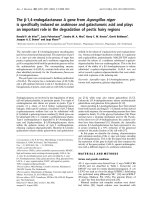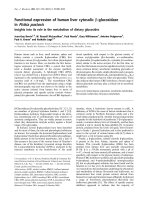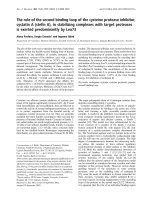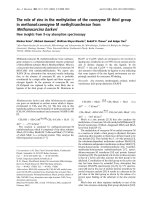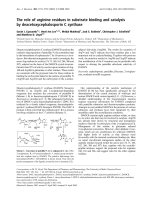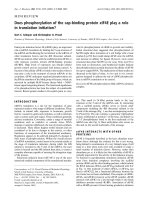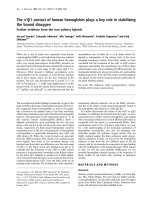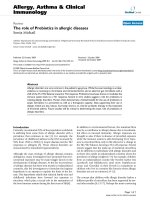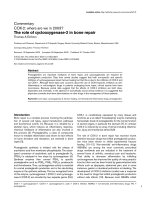Báo cáo y học: "The role of structural genes in the pathogenesis of osteoarthritic disorder" potx
Bạn đang xem bản rút gọn của tài liệu. Xem và tải ngay bản đầy đủ của tài liệu tại đây (89.39 KB, 9 trang )
337
ANKH = human homologue of the mouse progressive ankylosis (ank) gene; COMP = cartilage oligomeric matrix protein; CMP = cartilage matrix
protein; IL-1 = interleukin-1; MED = multiple epiphyseal dysplasia; OA = osteoarthritis; PGOA = primary generalized osteoarthritis; SED = spondy-
loepiphyseal dysplasia; TGFβ1 = transforming growth factor beta 1.
Available online />Introduction
Osteoarthritis (OA), the most common form of arthritis, is
no longer regarded as a simple consequence of age-
related cartilage degeneration, but rather is regarded as
the result of an active process, which may be regenerative
rather than degenerative in nature. Furthermore, OA is
probably not a single disorder, but rather a group of over-
lapping distinct diseases. These diseases are the conse-
quences of mechanical or biological events that
destabilize the normal coupling of synthesis and degrada-
tion of extracellular matrix in articular cartilage and sub-
chondral bone. It is commonly assumed that multiple
factors, including genetic and developmental, metabolic,
and traumatic factors can trigger osteoarthritic disease. At
later stages, the disease is characterized by molecular,
morphological, and biomechanical changes which lead to
softening, fibrillation, ulceration, and loss of articular carti-
lage, eburnation of subchondral bone, osteophytes, and
subchondral bone cysts [1]. Extracellular matrix molecules
play a critical role in the normal maintenance of articular
cartilage structure, regulation of chondrocyte proliferation
and gene expression, and cartilage aging and repair, and
they are important in the pathophysiology of OA.
Articular cartilage is composed of an extracellular matrix
designed to resist tensile and compressive forces and
provide a smooth surface to permit low-friction movement in
joints. These properties are the result of the interactions
between a large number of proteins and proteoglycans
present in the matrix (Fig. 1). Many of these components are
listed in Table 1; this list, which is by no means exhaustive,
includes those components that have been studied the
most. Type II collagen is the major collagenous component,
but collagens III, VI, IX, X, XI, XII, and XIV also contribute to
the mature cartilage matrix. Noncollagenous components
include large amounts of the hyaluronate-binding proteogly-
can aggrecan and its associated link protein, as well as
other collagen-binding proteoglycans, such as decorin,
fibromodulin, and lumican, and proteins such as PRELP
(proline/arginine-rich and leucine-rich repeat protein) and
cartilage oligomeric matrix protein (COMP) [2]. The struc-
ture and abundance of these components change with age
because of a combination of changes in both synthetic and
degradative events [3]. The effects of mutations in the
genes encoding these structural components of the matrix
have provided insight into the function of the individual gene
products in the pathogenesis of OA.
Osteoarthritis (OA), one of the most common age-related chronic disorders of articular cartilage, joints,
and bone tissue, represents a major public health problem. Genetic studies have identified multiple
gene variations associated with an increased risk of OA. These findings suggest that there is a large
genetic component to OA and that the disorder belongs in the multigenetic, multifactorial class of
genetic diseases. Studies of chondrodysplasias and associated hereditary OA have provided a better
understanding of the role of structural genes in the maintenance and repair of articular cartilage, in the
regulation of chondrocyte proliferation and gene expression, and in the pathogenesis of OA.
Keywords: cartilage, chromosomes, genetics, linkage, osteoarthritis
Review
The role of structural genes in the pathogenesis of osteoarthritic
disorders
Anthony M Reginato
1,2
and Bjorn R Olsen
1
1
Department of Cell Biology, Harvard Medical School, Boston, MA, USA
2
Department of Rheumatology, Allergy and Immunology, Massachusetts General Hospital, Boston, MA USA
Corresponding author: Bjorn R Olsen (e-mail: )
Received: 22 May 2002 Revisions received: 22 July 2002 Accepted: 26 July 2002 Published: 30 August 2002
Arthritis Res 2002, 4:337-345 (DOI 10.1186/ar595)
© 2002 BioMed Central Ltd (
Print ISSN 1465-9905; Online ISSN 1465-9913)
Abstract
338
Arthritis Research Vol 4 No 6 Reginato and Olsen
Large genetic component in osteoarthritis
Twin studies and cohort studies have highlighted a sur-
prisingly large genetic component to OA [4–6]. These
findings have prompted the search for predisposing genes
using parametric linkage analyses of rare families in which
OA segregates as a Mendelian trait, model-free linkage
analysis of affected sibling pairs, and association analysis
of known candidate genes. Linkage studies have high-
lighted chromosomes 1, 2, 4, 6, 7, 9,11-13,16,19, and X
as potential chromosomes with OA susceptibility genes
[7–15]. Chromosomes 2,4,7,11, and 16 have been identi-
fied in multiple genome-wide scans and are therefore the
most likely candidates. In addition, association analysis of
candidate genes suggests that COL2A1 (chromo-
some 12), COL1A1 (chromosome 17), COL9A1 (chromo-
some 6), COL11A2 (chromosome 6), CMP (cartilage
matrix protein) (chromosome 1), VDR (vitamin D receptor)
(chromosome 12), ER (estrogen receptor) (chromo-
some 6), IGF-1 (insulin-like growth factor 1)
(chromosome 12), aggrecan (chromosome 15), and
TGFβ1 (chromosome 19) may represent ‘osteoarthritic
genes’ [16–25]. These findings support the notion that
there is a large genetic component to OA and that the
disease can be classified as a multigenetic, multifactorial
genetic disease.
Hereditary osteoarthritis
Mutations in genes encoding molecules expressed in
cartilagenous tissue lead to hereditary OA [26,27]. The
phenotypic spectrum is quite broad, encompassing very
severe forms, which become manifest early in life, to mild
disorders, which become clinically evident only late in life.
Hereditary OA can be subdivided into conditions such as
early-onset OA associated with an underlying familial
osteochondrodysplasia, conditions associated with meta-
bolic joint diseases including crystal-associated
arthropathies (familial calcium pyrophosphate deposition
disease and familial hydroxyapatite deposition disease),
and primary generalized osteoarthritis (PGOA) with mild
dysplasia [26,27]. The familial osteochondrodysplasias
represent a heterogeneous group of disorders character-
ized by abnormalities in the development and growth of
articular and growth-plate cartilages. The term ‘chon-
drodysplastic rheumatism’ has been used to refer to these
forms of OA. They include the type II and type XI col-
lagenopathies, the multiple epiphyseal dysplasias (MEDs),
and the metaphyseal chondrodysplasias. They are usually
inherited as fully penetrant autosomal dominant disorders.
The expression of the OA phenotype occurs early in life,
with distinct radiographic changes that are different from
the nondysplastic forms of inherited OA.
Figure 1
Diagram showing the collagen components (collagens II, IX and XI) of cartilage fibril (top) and the association between the fibril and
noncollagenous components of cartilage, such as matrilin-3, COMP, and complexes of aggrecan, link protein and hyaluronan (bottom). COMP,
cartilage oligomeric matrix protein.
COLLAGEN IX
COLLAGEN XI
COLLAGEN II
MATRILIN-3
COMP
LINK PROTEIN
HYALURONAN
AGGRECAN CORE PROTEIN
339
Families with PGOA without dysplasia exhibit a higher inci-
dence of OA than is seen in the general population, with
premature development of Heberden’s and Bouchard’s
nodes and cartilage degeneration at multiple joints [28].
Early studies showed that first-degree relatives of PGOA
probands were twice as likely to have radiographically
visible generalized disease as a control population [29].
Structural genes responsible for familial osteochondrodys-
plasias were initially considered strong candidates also for
PGOA, on the basis that mutations in such genes could
cause a spectrum of phenotypes from the most severe
chondrodysplasia with associated OA to a very mild phe-
notype of OA only. For example, several point mutations in
the COL2A1 gene have been identified as causes of
severe forms of type II collagenopathies [30], but muta-
tions in this gene are also associated with milder pheno-
types. Thus, mutations in the COL2A1 gene have been
identified in PGOA/late-onset spondyloepiphyseal dyspla-
sia (SED). Mutations resulting in an Arg519Cys substitu-
tion have been identified in several unrelated families with
PGOA and mild chondrodysplasia [31–34]. The
Arg75Cys change has also been identified in a large
family with severe OA, crystal deposition disease, and
late-onset SED [35]. It is likely that the chondrocalcinosis
phenotype in this family is a secondary consequence of
the advanced and severe OA, since structural changes in
the articular cartilage extracellular matrix may predispose
to crystal formation [36,37]. Other heterozygous substitu-
tions in type II collagen, Gly976Ser [38] and Gly493Ser
[39], have been identified in other kindreds with mild dys-
plasia and early-onset OA.
More recent studies have not supported these initial ideas.
In fact, the loci identified on chromosomes 2, 4, 7, 11, and
16 as the most likely candidates for OA susceptibility
genes do not in general correspond to structural matrix
genes. Furthermore, although a recent cohort study found
that a specific COL2A1 haplotype seemed to predispose
to generalized radiographic OA [23], linkage analysis of
14 candidate genes in OA kindreds resulted in the exclu-
sion of 10 important cartilage genes, including COL2A1
[40]. Analysis of 47 families with the phenotype of early-
onset primary OA without an SED phenotype failed to
detect mutations in the COL2A1 in most families, with the
exception of one case [41]. Other studies using multi-
allelic polymorphism and genetic analysis of sibling pairs
failed to identify COL2A1 as the disease locus in families
with features of PGOA in the absence of SED [42,43].
Therefore, a majority of patients with PGOA are likely to
have mutations in genes other than COL2A1 and other
structural matrix genes.
Familial osteochondrodysplasias
OA associated with familial osteochondrodysplasias
caused by mutations in (mostly) structural cartilage matrix
genes represents a subset of secondary OA. Studies of
this form of OA, however, are important as they provide
insights into the molecular processes that lead to articular
cartilage destruction in all forms of OA.
Table 2 summarizes genetic defects in structural macro-
molecules of cartilage that lead to alterations in chondro-
genesis, skeletal malformations, reduced skeletal function,
or predisposition to injury and OA. Mutations in type II col-
lagen cause a spectrum of diseases known as ‘type II col-
lagenopathies’. The severity ranges from developmental
lethality (achondrogenesis type II, hypochondrogenesis),
to moderately severe dwarphism (SED, Kniest dysplasia),
to normal stature with premature OA. In the case of lethal
mutations with absence of type II collagen, some embry-
onic cartilage develops with type I collagen susbstituted
for type II collagen, and bone is formed [44]. Mutations
Available online />Table 1
The most-studied components of cartilage matrix
Collagens
Types IIa and IIb
Type III
Type VI
Type IX
Type X
Type XI
Type XII
Type XIV
Proteoglycans
Aggrecan
Versican
Link protein
Biglycan (DS-PGI)
Decorin (DS-PGII)
Epiphycan (DS-PGIII)
Fibromodulin
Lumican
Perlecan
Proteoglycan 4
Noncollagenous proteins
COMP (cartilage oligomeric matrix protein; thrombospondin-5)
CMP (cartilage matrix protein; matrilin-1)
Matrilin-3
CILP (cartilage intermediate layer protein)
Fibronectin
PRELP (proline/arginine-rich and leucine-rich repeat protein)
Chondroadherin
Fibrillin
Tenascin-C
Elastin
MGP (matrix Gla protein)
Chondromodulin-I
Chondromodulin-II
CD-RAP (cartilage-derived retinoic acid-sensitive protein)
ANKH
Matrix metalloproteinases and related enxymes
Tissue inhibitors of metalloproteinases
340
Arthritis Research Vol 4 No 6 Reginato and Olsen
Table 2
Structural gene mutations in cartilage that result in abnormal cartilage matrix
OMIM# Gene name Gene symbol Diseases and disorders
12140 Collagen, type II α1 COL2A1 Achondrogenesis, type II
Achondrogenesis–hypochondrogenesis, type II
Epiphyseal dysplasia, multiple, with myopia and conductive deafness
Hypochondrogenesis
Kniest dysplasia
Osteoarthritis with mild dysplasia
Spondyloepiphyseal dysplasia, congenital type
Spondyloepiphyseal dysplasia, Namaqualand type
Spondyloepiphyseal dysplasia, Strudwick type
Spondyloepiphyseal dysplasia, various types
Spondyloepiphyseal dysplasia with precocious OA
Spondyloperipheral dysplasia
Stickler syndrome, type I
Wagner syndrome
120180 Collagen, type III α1 COL3A1 Arterial and aortic aneurysm
Ehlers–Danlos syndrome, types III and IV
120220 Collagen, type VI α1 COL6A1 Bethlem myopathy
120240 Collagen, type VI α2 COL6A2 Bethlem myopathy
Ullrich scleroatonic muscular dystrophy
120250 Collagen, type VI α3 COL6A3 Bethlem myopathy
120210 Collagen, type IX α1 COL9A1 Epiphyseal dysplasia, multiple, type 1
Intervertebral disk disease
120260 Collagen, type IX α2 COL9A2 Epiphyseal dysplasia, multiple, type 2
Intervertebral disk disease
120270 Collagen, type IX α3 COL9A3 Epiphyseal dysplasia, multiple, type 3
Epiphyseal dysplasia, multiple, with myopathy
120110 Collagen, type X α1 COL10A1 Metaphyseal chondrodysplasia, Schmid type
Spondylometaphyseal dysplasia, Japanese type
120260 Collagen, type XI α1 COL11A1 Stickler syndrome, type II
Marshall syndrome
120290 Collagen, type XI α2 COL11A2 Sensorineural deafness, autosomal dominant nonsyndromic
Otospondylomegaepiphyseal dysplasia
Stickler syndrome, type III
Weissenbacher–Zweymuller syndrome
600310 Cartilage oligomeric matrix protein COMP Pseudoachondroplasia
Epiphyseal dysplasia, multiple, Fairbanks type
Epiphyseal dysplasia, multiple, type 1
602109 Matrilin-3 MATN3 Multiple epiphyseal dysplasia, MATN3-related
Epiphyseal dysplasia, multiple, type 5
134797 Fibrillin FBN1 Marfan syndrome, various type
Ectopia lentis, familial
Marfanoid skeletal syndrome
MASS syndrome
Shprintzen–Goldberg syndrome
154870 Matrix γ-carboxyglutamic acid protein MGP Keutel syndrome
142461 Perlecan PLC Schwartz–Jampel syndrome, type 1
Dyssegmental dysplasia, Silverman–Handmaker type
Chondrodystrophic myotonia
222600 Diastrophic dysplasia sulfate transporter DTDST Achondrogenesis IB
Atelostogenesis type II
Diastrophic dysplasia
Epiphyseal dysplasia, multiple type 4
Diastrophic dysplasia, broad-bone–platyspondylic variant
604283 Proteoglycan 4 PRG4 Camptodactyly–arthropathy–coxa vara–pericarditis syndrome
605145 ANK ANKH Craniometaphyseal dysplasia, autosomal dominant
Chondrocalcinosis 2
MASS, mitral valve, aorta, skeleton, skin; OA, osteoarthritis; OMIM, Online Mendelian Inheritance in Man™.
341
that cause a moderately severe phenotype (SED, Kniest
dysplasia) generally result from reduced secretion of
type II collagen or reduced content of this collagen in car-
tilage [45–47]. The mildest phenotype (Stickler syndrome,
type I) is caused by premature stop codons resulting in a
null-allele mosaicism [47,48] and is associated with early-
onset OA. Several mouse models of the human type II col-
lagenopathies exist and resemble, depending on the type
and position of the mutation in the COL2A1 gene, a lethal
or a mild human phenotype [49–52].
Mutations in genes for type IX collagen result in MED. This
clinically heterogeneous disorder is characterized by mild
short stature and early-onset OA. In some families, splice-
site mutations in COL9A2 and COL9A3 causing skipping
of exon 3 in α2(IX) and α3(IX) transcripts, respectively
[53–58], are associated with a phenotype characterized
by normal to near-normal height, epiphyseal dysplasia of
several joints during childhood, and OA of the knees in
adulthood. A complex splicing defect of exon 8 and/or
exon 10 in the COL9A1 gene has been identified in other
families [59]. Consistent with these findings, transgenic
mice overexpressing a truncated α1(IX) chain (exerting a
dominant negative effect on assembly of collagen IX mole-
cules) exhibited mild chondrodysplasia and progressive
OA [60]. A similar phenotype was seen in mice carrying
two null alleles for COL9A1 [61]. Type IX collagen mole-
cules are heterotrimers composed of three different
polypeptide chains, α1(IX), α2(IX), and α3(IX), which are
localized on the surface of collagen-II-containing fibrils,
where they get cross-linked to residues within type II colla-
gen molecules and may help stabilize the fibrillar network
[62]. The absence of α1(IX) chains or expression of a
dominant negative form results in the absence or reduced
amounts of collagen IX in cartilage, and this may destabi-
lize the collagen network.
Mutations in the COL11A1 and COL11A2 genes, encod-
ing two of the polypeptide subunits of heterotrimeric colla-
gen XI molecules, give rise to the ‘type XI
collagenopathies’. COL11A1 mutations are associated
with Marshall or Stickler syndrome, characterized by
severe myopia, vitreoretinal degeneration, cleft palate,
midfacial hypoplasia, early-onset OA, and sensorineuronal
hearing loss [63–65]. Extensive genotype–phenotype cor-
relations of patients with Stickler, Stickler-like, or Marshall
syndrome have suggested that null-allele mutations in
COL2A1, encoding the polypeptide chains of collagen II
molecules as well as one of the chains in collagen XI,
cause the typical Stickler phenotype (in which vitreoretinal
degeneration is common and hearing loss is less
common), while splicing mutations in COL11A1 are
responsible for the Marshall syndrome (in which hearing
loss is common and vitreoretinal degeneration is less
common). Patients with glycine substitutions or small dele-
tions in COL11A1 (dominant negative mutations) may
have a mixed phenotype characteristic of both syndromes
[66]. Mutations in COL11A2 are associated with a nonoc-
ular Stickler-like syndrome, otospondylomegaepiphyseal
dysplasia [67–70], Weissenbacher–Zweymuller syn-
drome [69], or nonsyndromic forms of deafness called
DFNA13 (deafness, autosomal dominant nonsyndromic
sensorineural 13) [71]. The explanation for the lack of an
ocular phenotype in these syndromes is the presence of a
unique form of type XI collagen in the vitreous. In cartilage,
collagen XI molecules are heterotrimers of the products of
COL11A1, COL11A2, and COL2A1, but in the vitreous
the COL11A2 chain is replaced by a chain encoded by
COL5A2 [72].
The cho/cho mouse, which is homozygous for a premature
stop codon in the amino-terminal region of α1(XI) collagen
[73], has provided important insights into the role of colla-
gen XI in skeletal development. Heterozygous animals are
relatively unaffected; however, with age they develop
ostearthritis. Homozygous animals die at birth, with short
limbs, short snout, and cleft palate. Growth-plate carti-
lages show a disorganized structure with thick collagen
fibrils. The presence of thick fibrils, providing direct evi-
dence of a role of type XI collagen in regulating fibril diam-
eters, leads to the formation of a large-pore network of
fewer fibrils in cho/cho cartilage than the small-pore
network of thin fibrils found in wild-type cartilage. The
changes in pore size causes the proteoglycan aggregates
to be more loosely entrapped within the mutant matrix than
in the wild type. Mice with Col11a2 null alleles are pheno-
typically comparable with patients who have otospondylo-
megaepiphyseal dysplasia, and their phenotype suggests
that the α2(XI) chain may be required for correct fibril
assembly or lateral association between individual colla-
gen fibrils [74].
Mutations that prevent glycosaminoglycan sulfation of
aggrecan cause chondrodysplastic phenotypes associ-
ated with achondrogenesis, atelostogenesis, diastrophic
dysplasia, and autosomal recessive MED [75]. MED and
pseudoachondroplasia can also be the result of mutations
in COMP, a pentameric molecule belonging to the throm-
bospondin family of matrix molecules and which is local-
ized in the pericellular, territorial matrix of chondrocytes.
The protein contains several repeat domains, including
eight calcium-binding, calmodulin-like repeats. Most
COMP mutations identified in patients with MED or
pseudoachondroplasia are amino acid substitutions that
may disturb calcium binding [76–78]. Mutations in the
gene encoding matrilin-3 [79] can also give an MED clini-
cal phenotype, a phenomenon which provides genetic evi-
dence for a functional interaction between aggrecan,
COMP, collagen IX, and matrilin-3 in cartilage [80].
Mutations in a gene encoding the core protein of a proteo-
glycan associated with articular cartilage cause campto-
Available online />342
dactyly–arthropathy–coxa vara–pericarditis syndrome [81].
This chondroitin sulfate proteoglycan, called superficial
zone protein, lubricin, or proteoglycan 4, is produced by
the superficial articular chondrocytes and synovial cells. It
is responsible for lubrication of the cartilage surface [82].
The synthesis is impaired in arthritic joints and downregu-
lated by inflammatory cytokines such as IL-1.
Mutation at the progressive ankylosis (ank) locus in the
mouse causes a progressive form of arthritis with deposi-
tion of apatite crystals, formation of bony outgrowths, joint
destruction, and ankylosis [83]. In humans, mutations in
the ank gene, ANKH, have been linked to craniometaphy-
seal dysplasia [84,85]. In addition, analysis of two families
from England and Argentina with familial calcium
pyrophosphate deposition disease have identified muta-
tions in ANKH [86,87]. An early-onset form of this disease
with severe PGOA has been linked also to a region on
chromosome 8q [88].
Interactions between structural genes and
environment
In addition to specific structural gene mutations, well-
established risk factors for OA include trauma, aging,
obesity, and gender [89,90]. This raises the question of
whether OA caused by mutations in structural genes is
the result of changes in articular cartilage that are funda-
mentally very different from those that underlie the age-
related, obesity-related, or trauma-related disease. We do
not believe this is the case and argue that the clearly
defined genetic abnormalities in structural components of
articular cartilage result in OA simply because they lower
the threshold at which biomechanical stress on the joint
induces the cascade of cellular and molecular events that
define this disease. For example, mutations in the struc-
tural components of cartilage may alter matrix–cell interac-
tions and thereby cellular responses to cytokines, leading
to apoptosis and matrix destruction. Alternatively, the
chondrocyte response to mechanical stress in an abnor-
mal matrix structure may result in different patterns of
structural protein expression, dedifferentiation, hypertro-
phy, regeneration, and an abnormal pyrophosphate syn-
thesis [91]. In addition, mutations in structural genes may
lead to changes in molecular interactions between various
components of the extracellular matrix, altering the thick-
ness and three-dimensional organization of the cartilage
collagen fibrils and destabilizing the cartilaginous matrix
[92–94]. One of the curious features of OA associated
with mutations in genes encoding structural matrix pro-
teins is the selectivity with which different joints may be
affected. Thus, affected members of families with OA as a
result of mutations in COL9A2 show primarily knee OA,
while mutations in COL11A2 may affect hip joints. Since
collagens IX and XI are coexpressed with collagen II in the
articular cartilage of all joints, this joint selectivity is quite
puzzling. We suggest that the answer may be found in a
more careful examination of the interactions between
intrinsic and extrinsic factors that contribute to joint devel-
opment and function.
Extrinsic factors such as physical activity, occupation, and
trauma, along with intrinsic factors such as abnormal joint
alignment, joint hypermobility, decreased muscle strength,
and varus–valgus deformity, may alter the biomechanics
and loading stress conditions of various joints in different
ways [95] and play a critical role in the selection of geneti-
cally susceptible joints.
Conclusion
OA is a genetically complex disorder. Mutations in genes
encoding structural components of articular cartilage give
rise to rare forms of highly penetrant inherited diseases
that are associated with early-onset OA, whereas the
more common forms of the same disease that occurs with
increased frequency at an older age are associated with
genetic risk factors in the form of common population
polymorphisms. As more mutations in the structural genes
of articular cartilage are identified, careful clinical analyses
will be required to understand the genotype–phenotype
spectrum of these forms of hereditary OA. As with other
multifactorial diseases, the initiation, progression, and
severity of the OA disorder may be influenced by multiple
environmental, hormonal, and intrinsic and extrinsic
factors, with multiple genes in any given individual. The
identification of the genetic pathways will be difficult and
will represent a great challenge in the near future. Of criti-
cal importance are studies to understand the gene–gene
and gene–environment interactions, using animal models.
These efforts should provide a better understanding of the
pathogenesis of OA as well as a basis for developing
earlier preventive strategies and providing targets for the
development of new forms of treatment.
Acknowledgements
We thank Mrs Y Pittel for patient and expert editorial assistance. This
work was supported by grants from the National Institutes of Health
AR36819 and AR36820 (to BR Olsen) and by an Arthritis Foundation
Arthritis Investigator Award (to AM Reginato).
References
1. Poole AR, Kojima T, Yasuda T, Mwale F, Kobayashi M, Laverty S:
Composition and structure of articular cartilage: a template
for tissue repair. Clin Orthop 2001, 391:S153-S160.
2. Poole AR: Cartilage in health and disease. In Arthritis and Allied
Conditions. A Textbook of Rheumatology, 14th edn. Edited by
Koopman W. New York: Lippincott Williams and Wilkins; 2001:
2260-2284.
3. Roughley PJ: Age-associated changes in cartilage matrix:
implications for tissue repair. Clin Orthop 2001, 391:S153-
160.
4. Spector TD, Cicuttini F, Baker J, Loughlin J, Hart D: Genetic influ-
ences on osteoarthritis in women: a twin study. BMJ 1996,
312:940-943.
5. Felson DT, Couropmitree NN, Chaisson CE, Hannan MT, Zhang
Y, McAlindon TE, LaValley M, Levy D, Myers RH: Evidence for a
Mendelian gene in a segregation analysis of generalized radi-
ographic osteoarthritis: the Framingham Study. Arthritis
Rheum 1998, 41:1064-1071.
Arthritis Research Vol 4 No 6 Reginato and Olsen
343
6. Hirsch R, Lethbridge-Cejku M, Hanson R, Scott WW Jr, Reichle
R, Plato CC, Tobin JD, Hochberg MC: Familial aggregation of
osteoarthritis: data from the Baltimore Longitudinal Study on
Aging. Arthritis Rheum 1998, 41:1227-1232.
7. Wright GD, Hughes AE, Regan M, Doherty M: Association of
two loci on chromosome 2q with nodal osteoarthritis. Ann
Rheum Dis 1996, 55:317-319.
8. Leppavuori J, Kujala U, Kinnunen J, Kaprio J, Nissila M, Heliovaara
M, Klinger N, Partanen J, Terwilliger JD, Peltonen L: Genome
scan for predisposing loci for distal interphalangeal joint
osteoarthritis: evidence for a locus on 2q. Am J Hum Genet
1999, 65:1060-1067.
9. Loughlin J, Mustafa Z, Irven C, Smith A, Carr AJ, Sykes B,
Chapman K: Stratification analysis of an osteoarthritis
genome screen-suggestive linkage to chromosomes 4, 6, and
16. Am J Hum Genet 1999, 65:1795-1798.
10. Chapman K, Mustafa Z, Irven C, Carr AJ, Clipsham K, Smith A,
Chitnavis J, Sinsheimer JS, Bloomfield VA, McCartney M, Cox O,
Cardon LR, Sykes B, Loughlin J: Osteoarthritis-susceptibility
locus on chromosome 11q, detected by linkage. Am J Hum
Genet 1999, 65:167-174.
11. Roby P, Eyre S, Worthington J, Ramesar R, Cilliers H, Beighton P,
Grant M, Wallis G: Autosomal dominant (Beukes) premature
degenerative osteoarthropathy of the hip joint maps to an 11-
cM region on chromosome 4q35. Am J Hum Genet 1999, 64:
904-908.
12. Mustafa Z, Chapman K, Irven C, Carr AJ, Clipsham K, Chitnavis J,
Sinsheimer JS, Bloomfield VA, McCartney M, Cox O, Sykes B,
Loughlin J: Linkage analysis of candidate genes as susceptibil-
ity loci for osteoarthritis-suggestive linkage of COL9A1 to
female hip osteoarthritis. Rheumatology (Oxford) 2000, 39:
299-306.
13. Loughlin J, Mustafa Z, Smith A, Irven C, Carr AJ, Clipsham K, Chit-
navis J, Bloomfield VA, McCartney M, Cox O, Sinsheimer JS,
Sykes B, Chapman KE: Linkage analysis of chromosome 2q in
osteoarthritis. Rheumatology (Oxford) 2000, 39:377-381.
14. Ingvarsson T, Stefansson SE, Gulcher JR, Jonsson HH, Jonsson
H, Frigge ML, Palsdottir E, Olafsdottir G, Jonsdottir T, Walters
GB, Lohmander LS, Stefansson K: A large Icelandic family with
early osteoarthritis of the hip associated with a susceptibility
locus on chromosome 16p. Arthritis Rheum 2001, 44:2548-
2555.
15. Demissie S, Cupples LA, Myers R, Aliabadi P, Levy D, Felson DT:
Genome scan for quantity of hand osteoarthritis: the Framing-
ham Study. Arthritis Rheum 2002,46:946-52.
16. Loughlin J, Irven C, Athanasou N, Carr A, Sykes B: Differential
allelic expression of the type II collagen gene (COL2A1) in
osteoarthritic cartilage. Am J Hum Genet 1995, 56:1186-1193.
17. Loughlin J, Sinsheimer JS, Mustafa Z, Carr AJ, Clipsham K,
Bloomfield VA, Chitnavis J, Bailey A, Sykes B, Chapman K: Asso-
ciation analysis of the vitamin D receptor gene, the type I col-
lagen gene COL1A1, and the estrogen receptor gene in
idiopathic osteoarthritis. J Rheumatol 2000, 27:779-784.
18. Ushiyama T, Ueyama H, Inoue K, Nishioka J, Ohkubo I, Hukuda S:
Estrogen receptor gene polymorphism and generalized
osteoarthritis. J Rheumatol 1998, 25:134-137.
19. Uitterlinden AG, Burger H, Huang Q, Odding E, Duijn CM,
Hofman A, Birkenhager JC, van Leeuwen JP, Pols HA: Vitamin D
receptor genotype is associated with radiographic
osteoarthritis at the knee. J Clin Invest 1997, 100:259-263.
20. Uitterlinden AG, Burger H, van Duijn CM, Huang Q, Hofman A,
Birkenhager JC, van Leeuwen JP, Pols HA: Adjacent genes, for
COL2A1 and the vitamin D receptor, are associated with sep-
arate features of radiographic osteoarthritis of the knee.
Arthritis Rheum 2000, 43:1456-1464.
21. Keen RW, Hart DJ, Lanchbury JS, Spector TD: Association of
early osteoarthritis of the knee with a Taq I polymorphism of
the vitamin D receptor gene. Arthritis Rheum 1997, 40:1444-
1449.
22. Meulenbelt I, Bijkerk C, Miedema HS, Breedveld FC, Hofman A,
Valkenburg HA, Pols HA, Slagboom PE, van Duijn CM: A genetic
association study of the IGF-1 gene and radiological
osteoarthritis in a population-based cohort study (the Rotter-
dam Study). Ann Rheum Dis 1998, 57:371-374.
23. Meulenbelt I, Bijkerk C, De Wildt SC, Miedema HS, Breedveld
FC, Pols HA, Hofman A, Van Duijn CM, Slagboom PE: Haplotype
analysis of three polymorphisms of the COL2A1 gene and
associations with generalised radiological osteoarthritis. Ann
Hum Genet 1999, 63:393-400.
24. Yamada Y, Okuizumi H, Miyauchi A, Takagi Y, Ikeda K, Harada A:
Association of transforming growth factor beta1 genotype
with spinal osteophytosis in Japanese women. Arthritis Rheum
2000, 43:452-460.
25. Horton WE Jr, Lethbridge-Cejku M, Hochberg MC, Balakir R,
Precht P, Plato CC, Tobin JD, Meek L, Doege K: An association
between an aggrecan polymorphic allele and bilateral hand
osteoarthritis in elderly white men: data from the Baltimore
Longitudinal Study of Aging (BLSA). Osteoarthritis Cartilage
1998, 6:245-251.
26. Jimenez SA, Williams CJ, Karasick D: Hereditary osteoarthritis.
In Osteoarthritis. Edited by Brandt KD, Doherty M, Lohmander LS.
Oxford: Oxford University Press; 1998:31-49.
27. Jimenez SA, Williams CJ: Genetic and metabolic aspects. In
Osteoarthritis: Clinical and Experimental Aspects. Edited by
Reginster J-Y, Pelletier J-P, Martel-Pelletier J, Henrotin Y. Berlin,
New York: Springer; 1999:134-156.
28. Kellgren JH, Moore R: Generalized osteoarthritis and Heber-
den’s nodes. Brit Med J 1952, 1:181-187.
29. Kellgren JH, Lawrence JS, Bier F: Genetic factors in generalized
osteo-arthritis. Ann Rheum Dis 1963, 22:237-255.
30. Kuivaniemi H, Tromp G, Prockop DJ: Mutations in fibrillar colla-
gens (types I, II, III, and XI), fibril-associated collagen (type
IX), and network-forming collagen (type X) cause a spectrum
of diseases of bone, cartilage, and blood vessels. Hum Mutat
1997, 9:300-315.
31. Ala-Kokko L, Baldwin CT, Moskowitz RW, Prockop DJ: Single
base mutation in the type II procollagen gene (COL2A1) as a
cause of primary osteoarthritis associated with a mild chon-
drodysplasia. Proc Natl Acad Sci USA 1990, 87:6565-6568.
32. Bleasel JF, Holderbaum D, Brancolini V, Moskowitz RW, Consi-
dine EL, Prockop DJ, Devoto M, Williams CJ: Five families with
arginine 519-cysteine mutation in COL2A1: evidence for three
distinct founders. Hum Mutat 1998,12:172-176.
33. Williams CJ, Considine EL, Knowlton RG, Reginato A, Neumann
G, Harrison D, Buxton P, Jimenez S, Prockop DJ: Spondyloepi-
physeal dysplasia and precocious osteoarthritis in a family
with an Arg75
→→
Cys mutation in the procollagen type II gene
(COL2A1). Hum Genet 1993, 92:499-505.
34. Bleasel JF, Bisagni-Faure A, Holderbaum D, Vacher-Lavenu MC,
Haqqi TM, Moskowitz RW, Menkes CJ: Type II procollagen gene
(COL2A1) mutation in exon 11 associated with spondyloepi-
physeal dysplasia, tall stature and precocious osteoarthritis. J
Rheumatol 1995, 22:255-261.
35. Reginato AJ, Passano GM, Neumann G, Falasca GF, Diaz-Valdez
M, Jimenez SA, Williams CJ: Familial spondyloepiphyseal dys-
plasia tarda, brachydactyly, and precocious osteoarthritis
associated with an arginine 75
→→
cysteine mutation in the pro-
collagen type II gene in a kindred of Chiloe Islanders. I. Clini-
cal, radiographic, and pathologic findings. Arthritis Rheum
1994, 37:1078-1086.
36. Bjelle AO: Morphological study of articular cartilage in
pyrophosphate arthropathy. (Chondrocalcinosis articularis or
calcium pyrophosphate dihydrate crystal deposition dis-
eases). Ann Rheum Dis 1972, 6:449-456.
37. Bjelle A: Cartilage matrix in hereditary pyrophosphate
arthropathy. J Rheumatol 1981, 8:959-964.
38. Williams CJ, McCarron S, Considine E: A point mutation in one
allele of the type II procollagengene produces a Gly976-Ser
substitution of the gene in a family with severe degenerative
arthropathy of the associated with probable epiphyseal dys-
plasia. Am J Hum Genet 1993, 53:A1252.
39. Karzentein PL, Campbell DF, Machado MA, Horton WA, Lee B,
Ramirez P: A type II collagen defect in a new family with SED
tarda and early-onset osteoarthritis (OA) [abstract]. Arthritis
Rheum 1992, 35:S41.
40. Meulenbelt I, Bijkerk C, Breedveld FC, Slagboom PE: Genetic
linkage analysis of 14 candidate gene loci in a family with
autosomal dominant osteoarthritis without dysplasia. J Med
Genet 1997, 34:1024-1027.
41. Ritvaniemi P, Korkko J, Bonaventure J, Vikkula M, Hyland J, Paas-
silta P, Kaitila I, Kaariainen H, Sokolov BP, Hakala M, Pertti M,
Meerson EM, Klemola T, Williams C, Peltonen L, Kivirikko KI,
Prockop DJ, Ala-Kokko LA: Identification of COL2A1 gene
mutations in patients with chondrodysplasias and familial
osteoarthritis. Arthritis Rheum 1995, 38:999-1004.
Available online />344
42. Vikkula M, Nissila M, Hirvensalo E, Nuotio P, Palotie A, Aho K, Pel-
tonen L: Multiallelic polymorphism of the cartilage collagen
gene: no association with osteoarthrosis. Ann Rheum Dis
1993, 52:762-764.
43. Loughlin J, Irven C, Fergusson C, Sykes B: Sibling pair analysis
shows no linkage of generalized osteoarthritis to the loci
encoding type II collagen, cartilage link protein or cartilage
matrix protein. Br J Rheumatol 1994, 33:1103-1106.
44. Chan D, Cole WG, Chow CW, Mundlos S, Bateman JF: A
COL2A1 mutation in achondrogenesis type II results in the
replacement of type II collagen by type I and III collagens in
cartilage. J Biol Chem 1995, 270:1747-1753.
45. Chan D, Cole WG: Low basal transcription of genes for tissue-
specific collagens by fibroblasts and lymphoblastoid cells.
Application to the characterization of a glycine 997 to serine
substitution in alpha 1(II) collagen chains of a patient with
spondyloepiphyseal dysplasia. J Biol Chem 1991, 266:12487-
12494.
46. Chan D, Taylor TK, Cole WG: Characterization of an arginine
789 to cysteine substitution in alpha 1 (II) collagen chains of a
patient with spondyloepiphyseal dysplasia. J Biol Chem 1993,
268:15238-15245.
47. Winterpacht A, Hilbert M, Schwarze U, Mundlos S, Spranger J,
Zabel BU: Kniest and Stickler dysplasia phenotypes caused
by collagen type II gene (COL2A1) defect. Nat Genet 1993, 3:
323-326.
48. Ahmad NN, Ala-Kokko L, Knowlton RG, Jimenez SA, Weaver EJ,
Maguire JI, Tasman W, Prockop DJ: Stop codon in the procolla-
gen II gene (COL2A1) in a family with the Stickler syndrome
(arthro-ophthalmopathy). Proc Natl Acad Sci USA 1991, 88:
6624-6627.
49. Vandenberg P, Khillan JS, Prockop DJ, Helminen H, Kontusaari S,
Ala-Kokko L: Expression of a partially deleted gene of human
type II procollagen (COL2A1) in transgenic mice produces a
chondrodysplasia. Proc Natl Acad Sci USA 1991, 88:7640-
7644.
50. Helminen HJ, Kiraly K, Pelttari A, Tammi MI, Vandenberg P, Pereira
R, Dhulipala R, Khillan JS, Ala-Kokko L, Hume EL, Sokolov BP,
Prockop DJ: An inbred line of transgenic mice expressing an
internally deleted gene for type II procollagen (COL2A1).
Young mice have a variable phenotype of a chondrodysplasia
and older mice have osteoarthritic changes in joints. J Clin
Invest 1993, 92:582-595.
51. Rintala M, Metsaranta M, Garofalo S, de Crombrugghe B, Vuorio
E, Ronning O: Abnormal craniofacial morphology and cartilage
structure in transgenic mice harboring a Gly
→→
Cys mutation
in the cartilage-specific type II collagen gene. J Craniofac
Genet Dev Biol 1993, 13:137-146.
52. Pace JM, Li Y, Seegmiller RE, Teuscher C, Taylor BA, Olsen BR:
Disproportionate micromelia (Dmm) in mice caused by a
mutation in the C-propeptide coding region of Col2a1. Dev
Dyn 1997, 208:25-33.
53. Briggs MD, Choi H, Warman ML, Loughlin JA, Wordsworth P,
Sykes BC, Irven CM, Smith M, Wynne-Davies R, Lipson MH,
Biesecker LG, Garber AP, Lachman R, Olsen BR, Rimoin DL, and
Cohn DH: Genetic mapping of a locus for multiple epiphyseal
dysplasia (EDM2) to a region of chromosome 1 containing a
type IX collagen gene. Am J Hum Genet 1994, 55:678-684.
54. Muragaki Y, Mariman EC, van Beersum SE, Perala M, van Mourik
JB, Warman ML, Olsen BR, Hamel BC: A mutation in the gene
encoding the alpha 2 chain of the fibril-associated collagen
IX, COL9A2, causes multiple epiphyseal dysplasia (EDM2).
Nat Genet 1996, 12:103-105.
55. van Mourik JB, Hamel BC, Mariman EC: A large family with mul-
tiple epiphyseal dysplasia linked to COL9A2 gene. Am J Med
Genet 1998, 77:234-240.
56. Paassilta P, Lohiniva J, Annunen S, Bonaventure J, Le Merrer M,
Pai L, Ala-Kokko L: COL9A3: A third locus for multiple epiphy-
seal dysplasia. Am J Hum Genet 1999, 64:1036-1044.
57. Spayde EC, Joshi AP, Wilcox WR, Briggs M, Cohn DH, Olsen
BR: Exon skipping mutation in the COL9A2 gene in a family
with multiple epiphyseal dysplasia. Matrix Biol 2000, 19:121-
128.
58. Lohiniva J, Paassilta P, Seppanen U, Vierimaa O, Kivirikko S, Ala-
Kokko L: Splicing mutations in the COL3 domain of collagen
IX cause multiple epiphyseal dysplasia. Am J Med Genet
2000, 90:216-222.
59. Czarny-Ratajczak M, Lohiniva J, Rogala P, Kozlowski K, Perala M,
Carter L, Spector TD, Kolodziej L, Seppanen U, Glazar R,
Krolewski J, Latos-Bielenska A, Ala-Kokko L: A mutation in
COL9A1 causes multiple epiphyseal dysplasia: further evi-
dence for locus heterogeneity. Am J Hum Genet 2001, 69:969-
980.
60. Nakata K, Ono K, Miyazaki J, Olsen BR, Muragaki Y, Adachi E,
Yamamura K, Kimura T: Osteoarthritis associated with mild
chondrodysplasia in transgenic mice expressing alpha 1(IX)
collagen chains with a central deletion. Proc Natl Acad Sci
USA 1993, 90:2870-2874.
61. Fassler R, Schnegelsberg PN, Dausman J, Shinya T, Muragaki Y,
McCarthy MT, Olsen BR, Jaenisch R: Mice lacking alpha 1 (IX)
collagen develop noninflammatory degenerative joint disease.
Proc Natl Acad Sci USA 1994, 91:5070-5074.
62. Mendler M, Eich-Bender SG, Vaughan L, Winterhalter KH, Bruck-
ner P: Cartilage contains mixed fibrils of collagen types II, IX,
and XI. J Cell Biol 1989, 108:191-197.
63. Richards, AJ, Yates, JRW, Williams R, Payne SJ, Pope FM, Scott
JD, Snead MP: A family with Stickler syndrome type 2 has a
mutation in the COL11A1 gene resulting in the substitution of
glycine 97 by valine in alpha-1(XI) collagen. Hum Molec Genet
1996, 5: 1339-1343.
64. Griffith AJ, Sprunger LK, Sirko-Osadsa DA, Tiller GE, Meisler MH,
Warman ML: Marshall syndrome associated with a splicing
defect at the COL11A1 gene. Am J Hum Genet 1998, 62: 816-
823.
65. Martin S, Richards AJ, Yates JRW, Scott JD, Pope M, Snead MP:
Stickler syndrome: further mutations in COL11A1 and evi-
dence for additional locus heterogeneity. Eur J Hum Genet
1999, 7:807-814.
66. Annunen S, Korkko J, Czarny M, Warman ML, Brunner HG, Kaari-
ainen H, Mulliken JB, Tranebjaerg L, Brooks DG, Cox GF, Cruys-
berg JR, Curtis MA, Davenport SL, Friedrich CA, Kaitila I,
Krawczynski MR, Latos-Bielenska A, Mukai S, Olsen BR, Shinno
N, Somer M, Vikkula M, Zlotogora J, Prockop DJ, Ala-Kokko L:
Splicing mutations of 54-bp exons in the COL11A1 gene
cause Marshall syndrome, but other mutations cause overlap-
ping Marshall/Stickler phenotypes. Am J Hum Genet 1999, 65:
974-983.
67. Vikkula M, Mariman EC, Lui VC, Zhidkova NI, Tiller GE, Goldring
MB, van Beersum SE, de Waal Malefijt MC, van den Hoogen FH,
Ropers H-H, Mayne R, Cheah K, Olsen BR, Warman ML, Brunner
HG: Autosomal dominant and recessive osteochondrodys-
plasias associated with the COL11A2 locus. Cell 1995, 80:
431-437.
68. van Steensel MA, Buma P, de Waal Malefijt MC, van den Hoogen
FH, Brunner HG: Oto-spondylo-megaepiphyseal dysplasia
(OSMED): clinical description of three patients homozygous
for a missense mutation in the COL11A2 gene. Am J Med
Genet 1997, 70:315-323.
69. Pihlajamaa T, Prockop DJ, Faber J, Winterpacht A, Zabel B,
Giedion A, Wiesbauer P, Spranger J, Ala-Kokko L: Heterozygous
glycine substitution in the COL11A2 gene in the original
patient with the Weissenbacher-Zweymuller syndrome
demonstrates its identity with heterozygous OSMED (nonocu-
lar Stickler syndrome). Am J Med Genet 1998, 80:115-120.
70. Melkoniemi M, Brunner HG, Manouvrier S, Hennekam R, Superti-
Furga A, Kaariainen H, Pauli RM, van Essen T, Warman ML,
Bonaventure J, Miny P, Ala-Kokko L: Autosomal recessive disor-
der otospondylomegaepiphyseal dysplasia is associated with
loss-of-function mutations in the COL11A2 gene. Am J Hum
Genet 2000, 66:368-377.
71. McGuirt WT, Prasad SD, Griffith AJ, Kunst HP, Green GE,
Shpargel KB, Runge C, Huybrechts C, Mueller RF, Lynch E, King
MC, Brunner HG, Cremers CW, Takanosu M, Li SW, Arita M,
Mayne R, Prockop DJ, Van Camp G, Smith RJ: Mutations in
COL11A2 cause non-syndromic hearing loss (DFNA13). Nat
Genet 1999, 23:413-419.
72. Mayne R, Brewton RG, Mayne PM, Baker JR: Isolation and char-
acterization of the chains of type V/type XI collagen present
in bovine vitreous. J Biol Chem 1993, 268:9381-9386.
73. Li Y, Lacerda DA, Warman ML, Beier DR, Yoshioka H, Ninomiya
Y, Oxford JT, Morris NP, Andrikopoulos K, Ramirez F, Wardell BB,
Lifferth GD, Teuscher C, Woodward SR, Taylor BA, Seegmiller
RE, Olsen BR: A fibrillar collagen gene, Col11a1, is essential
for skeletal morphogenesis. Cell 1995, 80:423-430.
Arthritis Research Vol 4 No 6 Reginato and Olsen
345
74. Li SW, Takanosu M, Arita M, Bao Y, Ren ZX, Maier A, Prockop DJ,
Mayne R: Targeted disruption of Col11a2 produces a mild car-
tilage phenotype in transgenic mice: Comparison with the
human disorder otospondylomegaepiphyseal dysplasia
(OSMED). Dev Dyn 2001, 222:141-152.
75. Superti-Furga A, Neumann L, Riebel T, Eich G, Steinmann B,
Spranger J, Kunze J: Recessively inherited multiple epiphyseal
dysplasia with normal stature, club foot, and double layered
patella caused by a DTDST mutation. J Med Genet 1999, 36:
621-624.
76. Briggs MD, Hoffman SM, King LM, Olsen AS, Mohrenweiser H,
Leroy JG, Mortier GR, Rimoin DL, Lachman RS, Gaines ES, Cek-
leniak JA, Knowlton, RG, Cohn DH: Pseudoachondroplasia and
multiple epiphyseal dysplasia due to mutations in the carti-
lage oligomeric matrix protein gene. Nat Genet 1995, 10:330-
336.
77. Deere M, Sanford T, Francomano CA, Daniels K, Hecht JT: Identi-
fication of nine novel mutations in cartilage oligomeric matrix
protein in patients with pseudoachondroplasia and multiple
epiphyseal dysplasia. Am J Med Genet 1999, 85:486-490.
78. Thur J, Rosenberg K, Nitsche DP, Pihlajamaa T, Ala-Kokko L,
Heinegard D, Paulsson M, Maurer P: Mutations in cartilage
oligomeric matrix protein causing pseudoachondroplasia and
multiple epiphyseal dysplasia affect binding of calcium and
collagen I, II, and IX. J Biol Chem 2001, 276:6083-6092.
79. Chapman KL, Mortier GR, Chapman K, Loughlin J, Grant ME,
Briggs MD: Mutations in the region encoding the von Wille-
brand factor A domain of matrilin-3 are associated with multi-
ple epiphyseal dysplasia. Nat Genet 2001, 28:393-396.
80. Holden P, Meadows RS, Chapman KL, Grant ME, Kadler KE,
Briggs MD: Cartilage oligomeric matrix protein interacts with
type IX collagen, and disruptions to these interactions identify
a pathogenetic mechanism in a bone dysplasia family. J Biol
Chem 2001, 276:6046-6055.
81. Marcelino J, Carpten JD, Suwairi WM, Gutierrez OM, Schwartz S,
Robbins C, Sood R, Makalowska I, Baxevanis A, Johnstone B,
Laxer RM, Zemel L, Kim CA, Herd JK, Ihle J, Williams C, Johnson
M, Raman V, Alonso LG, Brunoni D, Gerstein A, Papadopoulos N,
Bahabri SA, Trent JM, Warman ML: CACP, encoding a secreted
proteoglycan, is mutated in camptodactyly-arthropathy-coxa
vara-pericarditis syndrome. Nat Genet 1999, 23:319-322.
82. Flannery CR, Hughes CE, Schumacher BL, Tudor D, Aydelotte
MB, Kuettner KE, Caterson B: Articular cartilage superficial
zone protein (SZP) is homologous to megakaryocyte stimu-
lating factor precursor and Is a multifunctional proteoglycan
with potential growth-promoting, cytoprotective, and lubricat-
ing properties in cartilage metabolism. Biochem Biophys Res
Commun 1999, 254:535-541.
83. Ho AM, Johnson MD, Kingsley DM: Role of the mouse ank gene
in control of tissue calcification and arthritis. Science 2000,
289:265-270.
84. Nurnberg P, Thiele H, Chandler D, Hohne W, Cunningham ML,
Ritter H, Leschik G, Uhlmann K, Mischung C, Harrop K, Goldblatt
J, Borochowitz ZU, Kotzot D, Westermann F, Mundlos S, Braun
HS, Laing N, Tinschert S: Heterozygous mutations in ANKH,
the human ortholog of the mouse progressive ankylosis
gene, result in craniometaphyseal dysplasia. Nat Genet 2001,
28:37-41.
85. Reichenberger E, Tiziani V, Watanabe S, Park L, Ueki Y, Santanna
C, Baur ST, Shiang R, Grange DK, Beighton P, Gardner J,
Hamersma H, Sellars S, Ramesar R, Lidral AC, Sommer A,
Raposo do Amaral CM, Gorlin RJ, Mulliken JB, Olsen BR: Auto-
somal dominant craniometaphyseal dysplasia is caused by
mutations in the transmembrane protein ANK. Am J Hum
Genet 2001, 68:1321-1326.
86. Pendleton A, Johnston M, Ho A, Gurley K, Kingsley D, Wright GD,
Dixey J, Doherty M, Hughes AE: A heterozygous mutation in the
human ANK gene in a British family with adult onset chondro-
calcinosis due to calcium pyrophosphate crystal deposition
[abstract]. Arthritis Rheum 2001, 44:S101.
87. Johnson M, Ho A, McGrath R, Netter P, Loeuille D, Jonveaux P,
Gaucher A, Reginato A, Gurley K, Kingsley D, Williams CJ: Analy-
sis of ANK gene reveals heterozygous missense mutation in
a French family with calcium pyrophosphate deposition
disease (CPPDD). Arthritis Rheum 2001, 9:S161.
88. Baldwin CT, Farrer LA, Adair R, Dharmavaram R, Jimenez S,
Anderson L: Linkage of early-onset osteoarthritis and chon-
drocalcinosis to human chromosome 8q. Am J Hum Genet
1995, 56:692-697.
89. Sowers M: Epidemiology of risk factors for osteoarthritis: sys-
temic factors. Curr Opin Rheumatol 2001, 13:447-451.
90. Sharma L: Local factors in osteoarthritis. Curr Opin Rheumatol
2001, 13:441-446.
91. Sandell LJ, Aigner T: Articular cartilage and changes in arthritis.
An introduction: cell biology of osteoarthritis. Arthritis Res
2001, 3:107-113.
92. Fertala A, Ala-Kokko L, Wiaderkiewicz R, Prockop DJ: Collagen II
containing a Cys substitution for arg-alpha1-519.
Homotrimeric monomers containing the mutation do not
assemble into fibrils but alter the self-assembly of the normal
protein. J Biol Chem 1997, 272:6457-6464.
93. Fertala A, Sieron AL, Adachi E, Jimenez SA: Collagen II contain-
ing a Cys substitution for Arg-alpha1-519: abnormal interac-
tions of the mutated molecules with collagen IX. Biochemistry
2001, 40:14422-14428.
94. Holden P, Meadows RS, Chapman KL, Grant ME, Kadler KE,
Briggs MD: Cartilage oligomeric matrix protein interacts with
type IX collagen, and disruptions to these interactions identify
a pathogenetic mechanism in a bone dysplasia family. J Biol
Chem 2001, 276:6046-6055.
95. Wu JZ, Herzog W, Epstein M: Joint contact mechanics in the
early stages of osteoarthritis. Med Eng Phys 2000, 22:1-12.
Correspondence
Bjorn R Olsen, PhD, MD, Department of Cell Biology, Harvard Medical
School, 240 Longwood Ave, Boston, MA 02115, USA. Tel: +1 617 432
1874; fax +1 617 432 0638; e-mail:
Available online />
